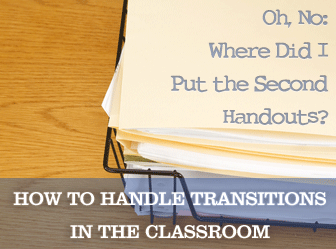Oh, No: Where Did I Put the Second Handouts? Handling Transitions in the Classroom


And your lesson that day had depended on those copies. In fact, the more you depend on a set of copies, it seems, the more likely it is the copy machine will jam, break, and go out of commission for the day. The same goes for overhead projectors and computers: the more you rely on them, the more likely they are to fall apart. So what do you do on those days when everything seems to be conspiring against having a good class?
The most important thing is to not panic and to breathe. Beginning teachers, in particular, might go into a minor panic attack over this kind of situation (I remember I did). However, the situation is not as dire as it seems although it may appear so with forty students waiting for you and your now-obsolete lesson. However, panic prevents you from breathing, which prevents you from thinking effectively. Remember to breathe.
When lesson planning, it’s best to plan ahead for things going wrong, as they generally will. Plan ahead for the copy machine breaking down. Can you write what is on the handout on the board? Or do you have an alternate activity? Some teachers have a series of activities in their “repertoires,” ready to pull out at a moment’s notice. One such activity I have, for example, is writing “Find Someone Who—“on the board, and then finishing the sentences with ten items: e.g. 1. has been to France. 2. has ridden on an elephant, and so on. This can be adapted for whatever students are studying. If they are studying the past tense, I would phrase the questions in various forms of the past tense. The goal is for students to copy the questions down and then to write a name by each question—which means they will have to go around the room and learn people’s names, which they might not have yet. This is an easily adaptable activity, and students usually enjoy it.
If students have some ongoing project they are working on, give them time to work on that. Usually in an English class, there is at least one ongoing project that there never seems to be time for. This might be that day for students to get into their groups and finish their research projects or collaborative stories.
I know some teachers who actually like days when they forget their books or the copy machine breaks, and so forth, because this brings out their most creative side; they feel inspired by the need to create that perfect lesson. While I wouldn’t recommend deliberately not planning, because the majority of good instruction does come out of careful planning, a way to see the occasion is one in which you can use your creativity. Take a moment to scan the learning objectives. What way can you possibly teach them without the planned resources? For example, can you teach paragraph structure without the graphic organizer showing neat paragraphs with topic sentences? How about by brainstorming details about the classroom together and then coming up with a suitable topic sentence based on the details? Students can then practice this In pairs based on the school, the yard, the park down the street, etc. It allows for creativity on the students’ parts and requires few resources other than pencil and paper and the whiteboard.
Most students are very willing to help when the need arises, so ask them to share handouts, write material on the board, and so forth. Call on volunteers to help or get the whole class to pitch in. Students usually appreciate the feeling of being needed and of being an equal to the teacher who can help.
Other teachers are also usually helpful to another teacher in a jam. They’ll willingly help you with the copier, show you where extra books are stored, and so forth. The only time they might show reluctance to help is when they are so swamped with their own classes that they are unable to—which might make that teacher a prime candidate for help when you are more able to offer it.
Most ESL students can use some work on conversational fluency in English. On the board, or on index cards if you have them, write common topics of conversation in English: “The Weather,” “Work,” “School,” “Movies,” and “Sports,” for example. Spend some time discussing what might be said on each topic, then have students get in pairs or groups, select a topic, and go!
Similar to conversational fluency, reading fluency is an area where most students could stand some practice. If there is a class library of any sort—even sets of newspapers or textbooks—this is an ideal opportunity to allow students to browse the material and select something to read. Have them fill out an informal report at the end, that you’ve written on the board, on what they’ve read: what the main idea is, any vocabulary learned, and one question about the reading. This provides some accountability while extending learning.
Finally, a teacher can always call a day where the plan went out the window a catch-up/advisory day, in which you’ll be available to give individual advice to students on their papers and conference with them about their work and grade. Far from this being a “free” day, this often ends up being one of the busiest of all because students readily respond to this offer, and they might be hanging around long after the period ends.
So those bad days when the copier breaks and you leave your briefcase at home do not have to be bad teaching days; in fact, with a little creativity, “those” days may end up being the best of all!
Do you ever have those bad days at school? What do you do?